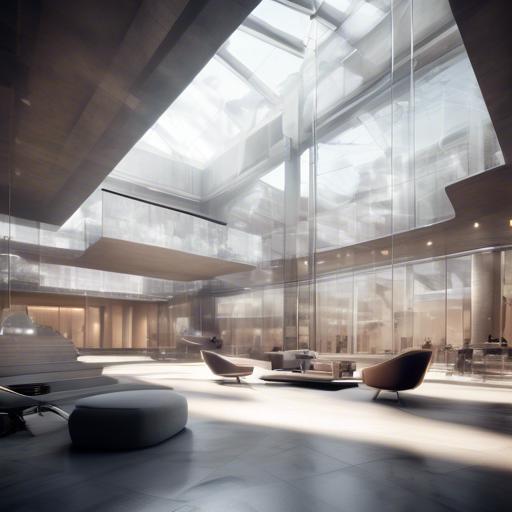Picture this: you step into a room, sunlight pouring through expansive windows, casting playful shadows on the walls. The texture of the oak flooring beneath your feet feels almost palpable, and you can practically smell the fresh paint on the artistically adorned walls. You’re not in a luxurious showroom; you’re in the virtual realm of architectural visualization, sculpted meticulously by the hands of artificial intelligence.
AI is not just a buzzword in technology circles; it’s a transformational key that is unlocking new dimensions in the realm of architecture. Gone are the days when blueprints and physical models were the sole mediums to envision a building’s potential. Today, with the power of AI, architectural visualization is reaching unprecedented heights in creativity and precision. This article delves into the myriad ways AI is revolutionizing how architects, clients, and stakeholders experience and design spaces—ushering in an era where imagination is the only limit, and dreams transform effortlessly into digital reality.
Join us on a journey through the innovative applications of AI in architectural visualization, and discover how this technology is not just augmenting our visual senses but also reshaping the very essence of architectural design.
Table of Contents
- Understanding the Role of AI in Modern Architecture
- Harnessing AI for Real-Time Design Adjustments
- Enhancing Visualization with AI-Driven Rendering Techniques
- Creating Interactive and Immersive Experiences with Virtual Reality
- Streamlining Project Management through Automated Workflows
- Leveraging Predictive Analytics for Robust Structural Planning
- Optimizing Resource Allocation with AI-Powered Tools
- Bridging the Gap Between Imagination and Reality
- Promoting Sustainable Design with Intelligent Simulations
- In Conclusion
Understanding the Role of AI in Modern Architecture
In modern architecture, the integration of artificial intelligence is reshaping the landscape of architectural visualization. No longer confined to traditional methods, architects are now leveraging AI to bring their visionary designs to life with unprecedented precision, efficiency, and creativity.
One of the most striking capabilities AI brings to the table is its ability to create **hyper-realistic renderings**. Utilizing advanced algorithms, AI can generate detailed 3D models, textures, and lighting that closely mimic real-world conditions. This allows architects to present their concepts not just as abstract blueprints, but as immersive, lifelike experiences.
- **Enhanced Design Accuracy:** AI reduces human error and increases the accuracy of design elements.
- **Time Efficiency:** With AI, rendering times are significantly faster, allowing for rapid prototyping and quicker client approvals.
- **Data-Driven Insights:** AI can analyze vast datasets to inform design decisions, ensuring that each project is optimized for functionality and aesthetic appeal.
Furthermore, AI’s role in architectural visualization extends to **interactive and adaptive design environments**. For instance, virtual and augmented reality platforms powered by AI enable stakeholders to engage with architectural models in real-time, making it easier to visualize spatial relationships, explore different finishing options, and assess the impact of various design changes instantly.
| Traditional Method | AI-Enhanced Visualization |
|---|---|
| Manual drafting and 2D renderings | Automatic 3D modeling and rendering |
| Long turnaround times | Rapid and efficient processing |
| Limited interactive capabilities | Immersive VR/AR experiences |
In essence, AI’s transformative power in architectural visualization is unlocking new potential for innovation and design excellence. By harnessing AI, architects are not only able to showcase their creative visions more vividly but also enhance collaborative efforts, leading to more successful, client-satisfying projects.
Harnessing AI for Real-Time Design Adjustments
Imagine making tweaks to your architectural designs in real-time, refining and adjusting details with just a few clicks. Artificial Intelligence (AI) is revolutionizing this possibility by streamlining the design process and empowering architects to be more creative and efficient. Through AI, real-time updates can be instantaneously simulated, visualized, and refined, making the design process smoother than ever before.
One of the brilliant applications of AI in architectural visualization is **dynamic design adjustment**. While working on a project, architects can input various parameters such as light, material, and spatial configurations to see immediate changes. This allows professionals to quickly test different design concepts, leading to more innovative solutions and enhancing client satisfaction.
- Instant Feedback: Gain quick insights into how minor adjustments will impact the overall aesthetic and functionality of the design.
- Enhanced Accuracy: Reduce human errors by having AI algorithms pinpoint potential issues and suggest improvements.
- Optimized Performance: Utilize AI to enhance design performance, balancing aesthetics with practical considerations like energy efficiency.
| AI Feature | Benefit |
|---|---|
| Real-Time Adjustments | Immediate visualization of design changes |
| Generative Design | Automated creation of design alternatives |
| Predictive Analysis | Forecasting design performance and feasibility |
Yet another fascinating capability of AI is **predictive modeling**. By analyzing historical data and current trends, AI can provide predictive insights into design feasibility and performance. This not only facilitates informed decision-making but also allows architects to anticipate potential issues and address them proactively.
Leveraging AI for real-time design adjustments doesn’t just accelerate the workflow—it transforms the very essence of architectural creativity and precision. By bridging the gap between visionary concepts and practical execution, AI empowers architects to bring their most imaginative designs to life with unprecedented ease and accuracy. As this technology continues to evolve, the possibilities for architectural innovation are truly limitless.
Enhancing Visualization with AI-Driven Rendering Techniques
AI-driven rendering techniques are revolutionizing the way architects visualize and present their projects. By leveraging the power of artificial intelligence, architectural visualization has become more immersive, interactive, and realistic. Here are some key ways AI enhances visualization:
- Augmented Reality (AR) and Virtual Reality (VR): AI can process vast amounts of data to create highly detailed 3D models that can be experienced through AR and VR. This allows clients to walk through a virtual version of the project before it’s even built.
- Automated Material Selection: AI algorithms can analyze a large database of materials and finishes to recommend the best options based on the project’s design criteria, sustainability goals, and budget constraints.
| Technique | Benefit |
|---|---|
| Generative Design | Explores numerous design permutations quickly |
| Neural Style Transfer | Applies artistic styles to 3D models |
| Real-Time Rendering | Immediate visualization of design changes |
Beyond visualization, AI can also enhance the workflow and productivity of architectural teams. **Predictive analytics** can forecast potential project bottlenecks, allowing for improved planning and resource allocation. By integrating these AI systems into their workflows, architects are able to focus more on creativity and design rather than spending excessive time on technical details.
Furthermore, **adaptive learning algorithms** improve the rendering quality over time by learning from past projects. These intelligent systems continuously refine their processes, offering higher quality visual representations with each new project. This means that the more you use AI, the better your results will be.
Creating Interactive and Immersive Experiences with Virtual Reality
Incorporating **virtual reality (VR)** into architectural visualization revolutionizes how we engage with spaces yet to be built. Previously limited to flat blueprints and 3D renderings, architects can now create fully immersive experiences, allowing clients to walk through buildings before they exist. This leap stems from the extraordinary capability of VR to simulate real-world environments with life-like precision and interactivity.
One of the brilliant aspects of VR in architecture is the ability to interact with the environment. Clients can:
- Open doors and windows
- Change the decor
- Manipulate lighting setups
- Switch between different material options for walls, floors, and furnishings
This form of **interactive exploration** helps clients make informed decisions, involving them deeply in the design process and reducing the revisions needed later.
Moreover, VR opens the door to **multi-sensory experiences** that add layers to architectural storytelling. Imagine strolling through a virtual garden and hearing the birds chirping or feeling the breeze through a haptic feedback device. These immersive experiences can emotionally connect clients to the project, making the envisioned space feel incredibly real. Enhanced detail can be seen in innovative uses of AI within VR, like dynamic environmental conditions and adaptive scenarios based on user interaction.
| VR Feature | Application |
|---|---|
| Photorealistic Rendering | Providing clients with stunning, lifelike visuals |
| Real-time Collaboration | Enabling multiple clients or stakeholders to experience and modify designs simultaneously |
| Scenario Simulation | Allowing visualization of different settings like day/night modes, seasonal changes, and weather conditions |
| Interactive Models | Manipulating the environment to test design choices |
Furthermore, integrating **AI-driven analytics** within VR can provide architects with valuable insights regarding user behavior and preferences. By analyzing how clients interact with the virtual environment—such as frequent paths taken, areas of focus, and elements interacted with most—architects can refine their designs to align more closely with client needs and expectations. This analytic feedback loop ensures a more user-centered design approach, ultimately elevating the quality and satisfaction of the final product.
Streamlining Project Management through Automated Workflows
In the fast-paced world of architectural visualization, time and detail are critical. **Automated workflows** infused with AI can significantly optimize project management, allowing architects and designers to focus more on creativity and less on mundane tasks. By employing sophisticated algorithms, AI can handle repetitive functions efficiently, ensuring that every major milestone is achieved within the designated timeframes.
One of the primary advantages of AI-automated workflows is the **seamless coordination between team members**. Imagine a scenario where updates in design plans or material specifications automatically trigger notifications to all stakeholders. This eliminates the need for constant check-ins and manual updates, leading to a more synchronized and efficient workflow.
Let’s look at a typical project management process enhanced by AI:
| Traditional Process | AI-Enhanced Workflow |
|---|---|
| Manual design updates | Automated, real-time updates |
| Frequent manual check-ins | Automated status reports |
| Individual task assignment | Intelligent task optimization |
**Intelligent resource allocation** is another area where AI shines. By analyzing project requirements and team capabilities, AI can dynamically allocate tasks to the most suitable team members, ensuring that projects are executed efficiently and effectively. This not only saves time but also maximizes the productivity of each team member.
By implementing AI in architectural visualization, companies can also benefit from predictive analytics. AI algorithms can forecast potential bottlenecks and suggest remedial measures even before issues arise. This preemptive approach enables project managers to be proactive rather than reactive, avoiding costly delays and ensuring timely project completion.
Leveraging Predictive Analytics for Robust Structural Planning
Incorporating predictive analytics into architectural planning allows for a data-driven approach that significantly enhances both the efficiency and reliability of design processes. By leveraging vast amounts of historical and real-time data, architects can anticipate potential structural issues long before they manifest, enabling proactive rather than reactive solutions.
**Predictive analytics** can forecast how different materials will perform under specific stress conditions, thereby aiding in the selection of the most suitable materials for a project. **Stress testing** and **load analysis** simulations can highlight weak points that might not be visible through traditional methods. This capability ensures that structures are not only aesthetically pleasing but also engineered for durability and safety.
- Enhanced load-bearing calculations
- Anticipation of material fatigue and failure
- Optimized resource allocation
Moreover, **structural integrity** is not the only area that benefits from predictive analytics. Energy efficiency can be maximized by analyzing how buildings interact with their environments. Predictive models can forecast the impact of seasonal changes and help design buildings that maintain optimal temperature with minimal energy use, thereby promoting sustainability.
| Feature | Benefit |
|---|---|
| Material Stress Testing | Ensures long-term durability |
| Load Analysis | Highlights structural weak points |
| Energy Efficiency Forecasting | Promotes sustainable building design |
**Cost management** is another critical area where predictive analytics can make a substantial impact. By forecasting potential structural issues, unnecessary expenditures on repairs and overhauls can be avoided. Financial resources can be allocated more effectively, resulting in significant cost savings over the lifecycle of a building project.
Ultimately, the integration of predictive analytics in architectural planning represents a revolutionary step forward, bridging the gap between **innovation** and **practicality**. The ability to foresee and counteract potential challenges before they arise not only improves the quality and safety of architectural designs, but it also streamlines project workflows, saving valuable time and resources.
Optimizing Resource Allocation with AI-Powered Tools
With **AI-powered tools**, architectural firms can significantly enhance their resource allocation strategies, ensuring that every project is delivered on-time and within budget. By leveraging artificial intelligence, the complexity of resource management is vastly reduced, and efficiency is maximized.
- Enhanced Decision-Making: AI provides critical insights and predictive analytics, enabling architects to make well-informed decisions about resource allocation.
- Real-Time Adjustments: Machine learning algorithms can analyze ongoing project data and suggest real-time modifications to resource allocation, improving adaptability and responsiveness.
- Cost Optimization: Predictive cost modeling powered by AI helps preempt and mitigate financial risks, ensuring that projects do not exceed budget.
Incorporating AI-driven project management platforms facilitates smoother interaction and collaboration among teams. These tools can automatically allocate tasks based on team member availability and expertise, ensuring that no resource is overburdened or underutilized. Another benefit is the identification of bottlenecks and resource gaps, aiding in rapid resolution and continuous workflow improvement.
For example, AI tools can optimize the usage of *3D rendering software* by determining the most efficient allocation of processing power and rendering resources, thereby reducing wait times and accelerating project completions. The following table provides a quick comparison of traditional resource allocation methods versus AI-powered techniques:
| Aspect | Traditional Methods | AI-Powered Techniques |
|---|---|---|
| Decision-Making | Manual Analysis | AI Predictive Analytics |
| Adaptability | Inflexible Plans | Real-Time Adjustments |
| Cost Management | Static Budgets | Dynamic Cost Optimization |
AI integration also enhances sustainability by providing eco-friendly resource management options. Architects can select materials and designs that minimize waste and reduce environmental impact through AI-driven recommendations. This not only fulfills a growing demand for green buildings but also aligns with global sustainability goals.
Ultimately, AI-powered tools empower architects to transcend traditional limitations, redefine project constraints, and deliver exceptional results with optimal resource utilization.
Bridging the Gap Between Imagination and Reality
In a world where creativity knows no bounds, AI serves as the bridge that connects imaginative designs to breathtaking architectural realities. Through innovations in AI, architects can now **visualize complex structures** with unprecedented clarity and precision, revolutionizing traditional methods of design and presentation.
Imagine being able to walk through an unbuilt structure in a fully immersive virtual environment. AI-enabled tools can generate **real-time renderings** that allow clients and architects to experience designs simultaneously. Here’s what AI can bring to the table:
- Speed and Efficiency: AI can dramatically reduce the time it takes to produce high-quality visualizations, ensuring faster decision-making and project turnaround.
- Enhanced Accuracy: By harnessing predictive algorithms, AI minimizes human error and improves the exactness of architectural details.
- Dynamic Adjustments: Real-time adjustments allow for immediate feedback and on-the-fly changes, fostering an collaborative environment between designers and clients.
AI can also assist in the **material selection process** by predicting how different materials will interact under various conditions, thus enabling more informed decisions. This capability not only enhances the quality of the final product but also ensures sustainability and cost-effectiveness.
Let’s not forget the impact of AI on **sustainability** in architecture. By utilizing AI-driven simulations, architects can predict the environmental impact of their designs. This encompasses everything from energy consumption to carbon footprint, enabling more eco-friendly projects.
| AI Feature | Benefit |
|---|---|
| Real-Time Renderings | Immediate visualization and feedback |
| Material Prediction | Informed material selection |
| Environmental Impact Simulations | Sustainable designs |
By embracing AI, the architectural industry is not just **adapting** to new technologies; it is redefining the boundaries of what is possible. As we continue to integrate these innovations, the line between imagination and reality becomes beautifully indistinct, leading us to a future where any dream can be built.
Promoting Sustainable Design with Intelligent Simulations
Incorporating artificial intelligence into the realm of architectural visualization allows architects to delve deeper into the realm of sustainable design. Leveraging AI-driven simulations helps professionals make informed choices, ensuring that every project minimizes environmental impact.
- **Energy Efficiency:** Through predictive models, AI can simulate how a building design will perform under various climatic conditions, helping optimize insulation, window placement, and material selection.
- **Water Use Optimization:** AI tools can predict water usage patterns and suggest designs that conserve water, whether through rainwater harvesting systems or smart irrigation designs.
- **Material Sustainability:** AI can assess the environmental impact of various building materials, aiding architects in choosing options that are both durable and eco-friendly.
Advanced AI simulations play a crucial role in **reducing the carbon footprint** of buildings. By running multiple iterations of design elements, AI can recommend configurations that expose the least amount of surface area to direct sunlight, thus reducing cooling requirements. This not only lowers energy consumption but also enhances the comfort of the building’s occupants.
| Design Aspect | AI Simulation Benefit |
|---|---|
| Lighting | Maximizes natural light while reducing energy use |
| Ventilation | Optimizes airflow to maintain indoor air quality |
| Heating | Ensures efficient temperature regulation |
Furthermore, AI-enhanced simulations facilitate **real-time feedback** from multiple stakeholders, making the design process more collaborative and inclusive. Architects can adjust designs on the fly based on insights from sustainability experts, local communities, and even future occupants, ensuring that the final blueprint respects environmental standards while catering to human needs.
In Conclusion
the potential for AI to revolutionize architectural visualization is truly awe-inspiring. By harnessing the power of artificial intelligence, architects and designers have the opportunity to unlock new levels of creativity, efficiency, and innovation in their work. The possibilities are endless, and the impact on the industry could be truly transformative. So let’s embrace the potential of AI in architecture and embark on this exciting journey toward a future where our wildest design dreams can be brought to life like never before. The future is bright, and with AI at our side, the sky’s the limit. Let’s design a better tomorrow together.
































